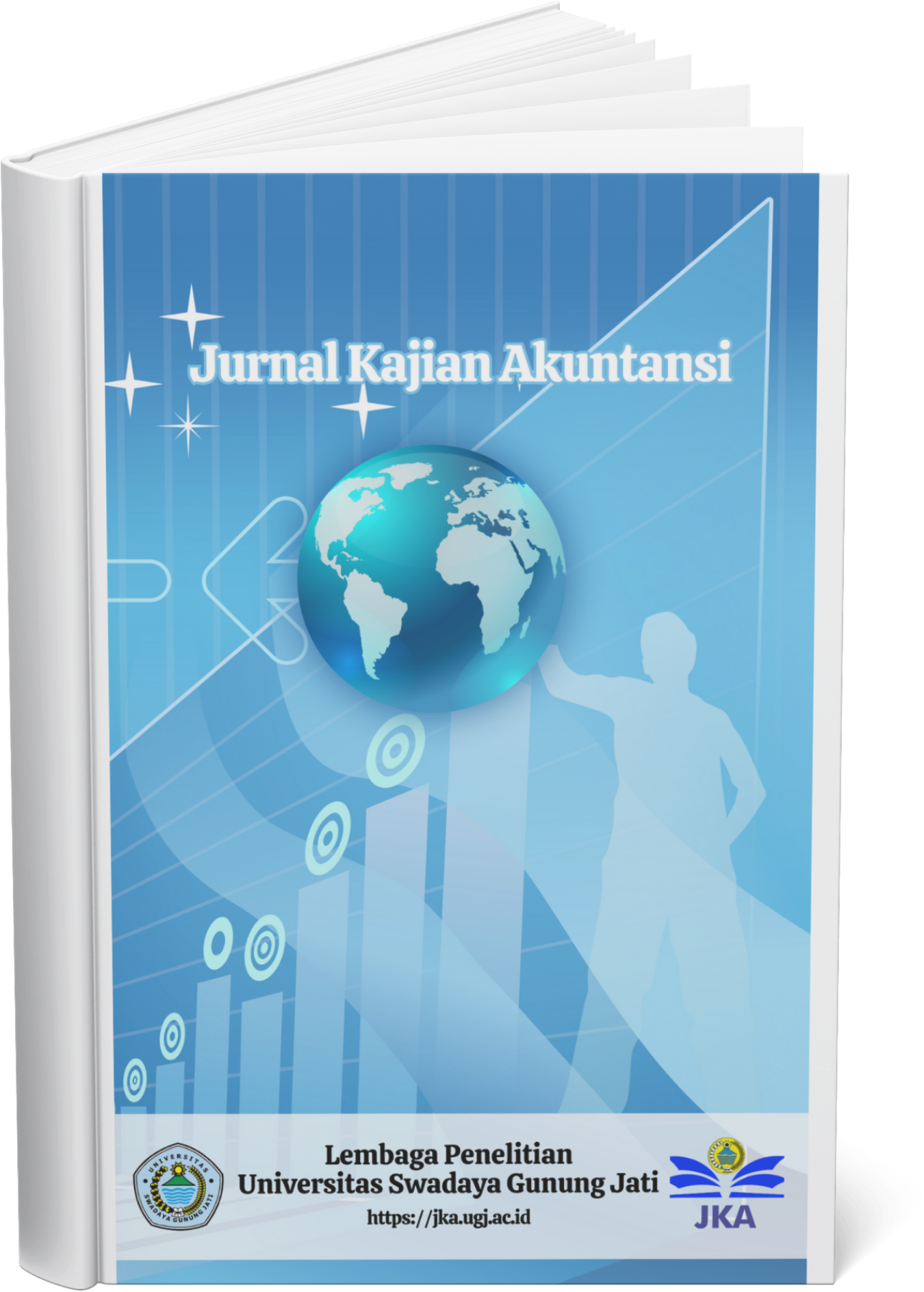Family in The Business and The Cost of Debt: Evidence from Family Firm in Indonesia
DOI:
https://doi.org/10.33603/jka.v8i1.9281Keywords:
Family company, Family involvement, Cost of debt, Panel dataAbstract
The issue of efficiency in choosing funding sources has become a concern for researchers, especially during the Covid 19 pandemic. Our research seeks to investigate whether family involvement and ownership can contribute to funding efficiency, especially from debt. Then we extended the test to see if earnings management behavior could affect family involvement and ownership. For this purpose, we collect family companies that are listed on the Indonesia Stock Exchange for the period 2005 to 2020. The method we use is panel data regression analysis. The results of the study prove that family involvement in management and share ownership is able to contribute to reducing the cost of debt during the covid 19 pandemic. The results also provide empirical evidence that earnings management carried out through abnormal cash flows does not affect family involvement and ownership in contributing to lowering the cost of debt. This research is expected to provide implications for family companies, especially in determining funding decisions from debt schemes.
References
Berrone, P., Cruz, C., & Gomez-Mejia, L. R. (2012). Socioemotional Wealth in Family Firms: Theoretical Dimensions, Assessment Approaches, and Agenda for Future Research. Family Business Review, 25(3), 258–279. https://doi.org/10.1177/0894486511435355.
Brahmono, A. Y. A., & Purwaningsih, A. (2022). Real Earnings Management Practices in Indonesia: Opportunist or Efficient Earnings Management Practices? Review of Integrative Business and Economics Research, 11(1), 191–200.
Callen, J. L., & Chy, M. (2023). The agency costs of investment opportunities and debt contracting: Evidence from exogenous shocks to government spending. Journal of Business Finance and Accounting, October, 1–31. https://doi.org/10.1111/jbfa.12769.
Cheng, B., Ioannou, I., & Sarafeim, G. (2014). Corporate social responsibility and access to finance. Strategic Management Journal, 35(1), 1–23. https://doi.org/10.1002/smj.
Doucouré, B., & Diagne, A. (2020). The effect of size and age on the performance of Senegalese small food companies: the role of market orientation. Transnational Corporations Review, 12(4), 363–373. https://doi.org/10.1080/19186444.2020.1832426.
Duréndez, A., Madrid-Guijarro, A., & Hernández-Cánovas, G. (2019). Do Family Firms’ Specific Governance Mechanisms Moderate the Cost of Debt? Australian Accounting Review, 29(1), 49–63. https://doi.org/10.1111/auar.12217.
Gao, H., He, J., Li, Y., & Qu, Y. (2020). Family control and cost of debt: Evidence from China. Pacific Basin Finance Journal, 60(December 2019), 101286. https://doi.org/10.1016/j.pacfin.2020.101286.
Ghardallou, W. (2022). Capital Structure Decisions and Corporate Performance: Does Firm’s Profitability Matter? Journal of Scientific and Industrial Research, 81(8), 859–865. https://doi.org/10.56042/jsir.v81i08.59697.
Hillier, D., Martínez, B., Patel, P. C., Pindado, J., & Requejo, I. (2018). Pound of flesh? debt contract strictness and family firms. Entrepreneurship: Theory and Practice, 42(2), 259–282. https://doi.org/10.1177/1042258717748933.
Jensen, M. C., & Meckling, W. H. (1976). Theory of The Firm Manajerial Behaviour, Ageny Cost and Ownership structure. Journal of Financial Economics, 3, 305–360.
Li, J., Wu, Z., & Zhang, L. (2021). Family involvement, external auditing, and the cost of debt: Evidence from U.S. small firms. Journal of Small Business Management, 59(4), 675–699. https://doi.org/10.1111/jsbm.12519.
Li Xi. (2015). Accounting Conservatism and the Cost of Capital : An International Analysis. Journal of Business Finance and Accounting, 42(7), 555–582. https://doi.org/10.1111/jbfa.12121.
Muttakin, M. B., Mihret, D., Lemma, T. T., & Khan, A. (2020). Integrated reporting, financial reporting quality and cost of debt. International Journal of Accounting and Information Management, 28(3), 517–534. https://doi.org/10.1108/IJAIM-10-2019-0124.
Palea, V., & Drogo, F. (2020). Carbon emissions and the cost of debt in the eurozone: The role of public policies, climate-related disclosure and corporate governance. Business Strategy and the Environment, 29(8), 2953–2972. https://doi.org/10.1002/bse.2550.
Pratama, A., Yadiati, W., & Jaenudin, E. (2024). Ownership structures, company size and age, and sustainable development goals are disclosed in the annual report: Is it acceptable to investors? (Survey among publicly listed companies in Indonesia). International Journal of Innovative Research and Scientific Studies, 7(1), 166–179. https://doi.org/10.53894/ijirss.v7i1.2595.
Roychowdhury, S. (2006). Earnings management through real activities manipulation. Journal of Accounting and Economics, 42(3), 335–370. https://doi.org/10.1016/j.jacceco.2006.01.002.
Rudiawarni, F. A., Sulistiawan, D., & Feliana, Y. K. (2017). When is earnings management really good news? Evidences from Indonesia. International Journal of Trade and Global Markets, 10(1), 47–57. https://doi.org/10.1504/IJTGM.2017.082375.
Santos, M. S., Moreira, A. C., & Vieira, E. S. (2014). Ownership concentration, contestability, family firms, and capital structure. In Journal of Management and Governance (Vol. 18, Issue 4). https://doi.org/10.1007/s10997-013-9272-7.
Shailer, G., & Wang, K. (2015). Government ownership and the cost of debt for Chinese listed corporations. Emerging Markets Review, 22, 1–17. https://doi.org/10.1016/j.ememar.2014.11.002.
Swanpitak, T., Pan, X., & Suardi, S. (2020). Family control and cost of debt: Evidence from Thailand. Pacific Basin Finance Journal, 62(June), 101376. https://doi.org/10.1016/j.pacfin.2020.101376.
Tabassum, N., Kaleem, A., & Nazir, M. S. (2015). Real Earnings Management and Future Performance. Global Business Review, 16(1), 21–34. https://doi.org/10.1177/0972150914553505.
Vander Bauwhede, H., De Meyere, M., & Van Cauwenberge, P. (2015). Financial reporting quality and the cost of debt of SMEs. Small Business Economics, 45(1), 149–164. https://doi.org/10.1007/s11187-015-9645-1.
Wang, G., Bai, J., Xing, J., Shen, J., Dan, E., Zheng, X., Zhang, L., Liu, P., & Feng, R. (2023). Operational Efficiency and Debt Cost: The Mediating Effect of Carbon Information Disclosure in Chinese Listed Companies. Sustainability (Switzerland), 15(2), 1–18. https://doi.org/10.3390/su15021512.
Downloads
Published
How to Cite
Issue
Section
License
- Authors retain copyright and grant the journal right of first publication with the work simultaneously licensed under a Creative Commons Attribution-ShareAlike (CC-BY-SA 4.0) that allows others to share the work with an acknowledgment of the work's authorship and initial publication in this journal.
- Authors are able to enter into separate, additional contractual arrangements for the non-exclusive distribution of the journal's published version of the work (e.g., post it to an institutional repository or publish it in a book), with an acknowledgment of its initial publication in this journal.
- Authors are permitted and encouraged to post their work online (e.g., in institutional repositories or on their website) prior to and during the submission process, as it can lead to productive exchanges, as well as earlier and greater citation of published work.
